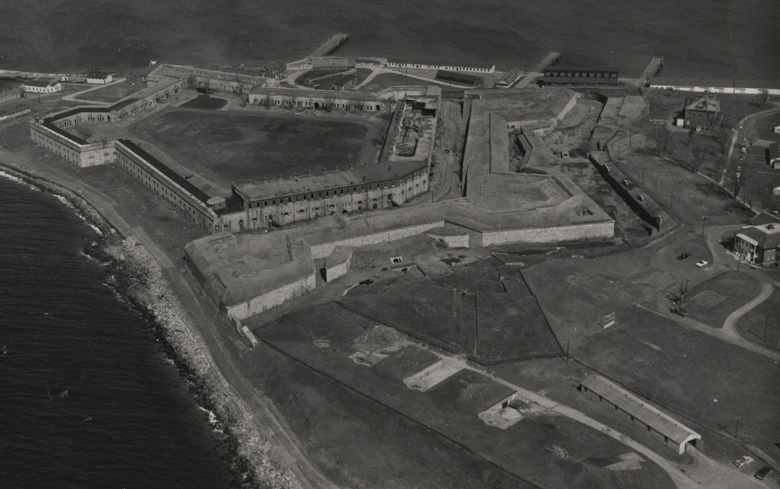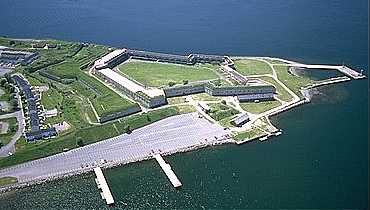Restoration Efforts (1965 - Present)

Fort Adams from Southwest circa early 1960's.
On May 21st, 1965 the fortification complex and the adjacent waterfront property was given by the Navy to the state of Rhode Island for use as a state park. This cleared the way for efforts to have the fort restored and opened to the public. These efforts were led by Newport State Senator Eric A. O'D. Taylor, Senator Claiborne Pell, Antoinette Downing of the Rhode Island Historic Preservation Commission and philanthropist John Nicholas Brown among many others. This resulted in the State of Rhode Island creating the Fort Adams Foundation charged with the redevelopment of the fort in 1976. (Providence Journal, May 22nd, 1965, pg. 24.)
Around 1972 Fort Adams was chosen to be documented by the Historic American Buildings Survey (HABS). The plans of the fort made by this effort will be invaluable in any restoration effort and are on file with the Rhode Island Histoic Preservation Commission and the National Archives. (Providence Journal, July 30th, 1972, pg. C10.)

Military Pagentry at Fort Adams circa mid-1970's.
In 1972 Mr. George Howarth was appointed as the fort's commandant and he oversaw daily operations which were hoped to have the fort redeveloped for the public benefit. On Monday September 4th, 1972 the fort was opened for tours for the first time since it was closed. About 2,000 people toured the fort that day. (Newport Daily News September 5th, 1972.)
This was the start of the fort being used as a major tourist attraction and events center until 1980. The Newport Jazz Festival began using Fort Adams as its venue as it does to this day.
One highlight was on July 6th, 1975 when the Boston Pops Esplanade Orchestra performed a concert inside the fort with the legendary Arthur Fieldler conducting.
In 1977 Fort Adams was declared by the Secretary of the Interior to be a National Historic Landmark which is the highest distinction a structure can have in the nation in relation to its historical and architectural significance. Fort Adams is one of fewer than 2,300 structures in the nation to have this designation.
In the summer of 1978 the movie "The Scarlet Letter" was filmed for the Public Broadcasting Service (PBS) at Fort Adams which highlighted the fort's potential as a film location.
In late 1978 the 1950's vintage Navy housing at Fort Adams was torn down. This was to make the land available for use as recreational space. The housing had been abandoned after the Navy pull out in 1973. (NDN, December 15th, 1978.)
In 1980 State Senator Eric Taylor died and the fort lost its biggest supporter in the state legislature. A number of other factors including budget shortfalls, concerns about safety and Mr. Howarth's reassignment led to the fort being closed to the public. For the next 13 years the fort would be mostly unused and fall victim to vandalism and natural decay.
On August 22nd and 23rd, 1981 the famous Newport Jazz Festival returned after several years of absence. Although festival promoter George Wein proposed Fort Adams as a site for the festival as early as 1963 it was not until the 1980's that this potential was realized. (Providence Bulletin, July 29th, 1963, pg. 1 and August 24th, 1981.)

Fort Adams viewed from the East circa the late 1970's.
(Image Courtesy of the Rhode Island Film Commission.)
In 1993 the Army Corps of Engineers announced that it was going to spend half a million dollars to remediate (i.e. clean up) the fort to make it accessible to the public. This led to renewed interest in the fort and the Fort Adams Foundation was revitalized under the leadership of Mr. Edwin Connelly of Jamestown, Colonel Frank Hale of the Newport Artillery Company and State Senator Theresa Paiva-Weed of Newport who served at the fort as a tourguide in the late 1970's.
The Army Corps remediation project was executed in the summer of 1994. It involved removing debris from the casemates, emplacing safty railings in hazardous areas and planting a "shubbery fence" to limit access to the fort's delapidated west wall. The effort coincideded with a State of Rhode Island initiative to install several ramps to improve the fort's handicapped accessibility. The end result was that Fort Adams could safely host visitors.
In May of 1995 Fort Adams was reopened for tours and public events during the summer months. The fort's potential as a major events center was demonstrated on May 18th, 1997 when a crowd estimated at 8,000 turned out for the first annual Fort Adams Adventure Day. Other major events in recent years have included the Jazz, Folk and Irish music festivals.
In 1997 Fort Adams was designated a Landmark at Risk by the National Park Service.